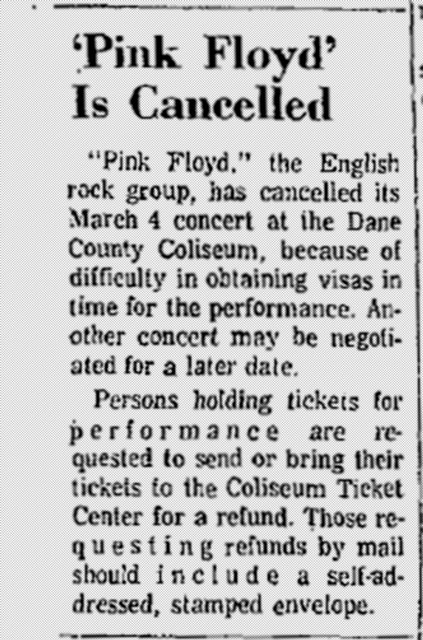
The first we heard that Pink Floyd was kicking off their 1973 North American tour in Madison, Wisconsin probably would have been on a WIBA-FM "Radio Free Madison" broadcast. Radio Free Madison was an "underground" music program that began broadcasting on Halloween night 1969 and continued into the early 1970s. It was on for only a few hours every night and played more album-oriented "head" music than anyone else was doing at that time. We'd been enjoying various tracks from Floyd's Atom Heart Mother and Meddle on Radio Free and there was buzz about their forthcoming album, the title of which was announced as Dark Side of the Moon: A Piece for Assorted Lunatics. As we were prime candidates, it sounded intriguing... I wanted to hear them live and so did a couple friends. The station began playing a promotional copy of the song Money. It featured an interesting time signature, 7/4 alternating with more typical 4/4 for the solos. Apparently, the 4/4 solos were done because David Gilmour thought it would be too complicated to write them in 7/4 time. Some music critics said the single dynamic of maintaining tempo but changing from seven beats to the bar to 8 beats added to the track's unique appeal. It also featured some pretty good sound effects which were supposed to be even better in quadraphonic (four-channel) sound, a format that Pink Floyd had been working with for a while and was becoming popular for vinyl LPs. I couldn't afford a quadraphonic audio system at that time, but a year or so later I had a friend who owned one and it was pretty impressive.
Before we got it together to think about buying tickets in advance, the concert was cancelled. This announcement was in the January 25, 1973 Madison Capital Times.

What a bummer! At least we hadn't bought tickets yet, so there was no hassle about getting a refund. We listened patiently for any more details about the the album release or a rescheduled concert date. Then, at last, an announcement came that the band had cleared up the matter of their visas. The concert was back on and the following ad was published in various Wisconsin State Journal issues during February.
.jpg)
Now we were psyched! Though as I recall, we hadn't bought tickets in advance. We traveled to the Coliseum from Janesville and thought we would arrive in plenty of time to buy them at the door. However, we hadn't considered the line of cars waiting to enter the parking lot. (Quick... roll the windows down and let the air clear!) As the car inched forward with each vehicle ahead of us stopping at the gatehouse to pay for parking, it seemed like an eternity. Eventually we paid and parked, then hoofed it to the main entrance. There were plenty of tickets available, but another line to wait in. The concert had already begun by the time the four of us entered the dark arena. This concert featured "festival seating," a euphemism for finding someplace to sit or stand on the arena floor along with 9,000 other . Alternatively, we could have chosen to sit in a seat around the perimeter, but we wanted to be in the middle of the ground-shaking quadraphonic sound system. With pink smoke and a laser light show in progress, an extended jam of "Obscured By Clouds" followed by "When You're In" was underway. Weaving through the crowd in the dark, someone bumped my elbow and a chunk of hashish flew from the pipe in my hand to the floor, never to be seen again.
According to author Glenn Povey in his book Echoes: The Complete History of Pink Floyd, the band's equipment for that tour was hauled in two forty-foot articulated trucks, with two drivers in each. They would meet the road crew at the venue at ten in the morning, usually after driving all night. The road crew, who traveled with the band, would be there when the truck arrived and then would begin setting up the equipment. Upon completing the setup at around four in the afternoon, the band would show up for their usual sound check.
Meanwhile, back inside the Coliseum, the music and lights were at full throttle. Right after "Careful With That Ax, Eugene" the band took a short intermission. They returned to the stage and the lights dimmed as the opening sound effects of "Speak To Me" filled the arena from a massive quad sound system. The band played the entire Dark Side with lasers blazing through the pink stage lights and into the upper regions of the hall. Among the most impressive effects, were the cash register and money-changing sounds that chased around the four massive speaker banks hung from the ceiling, all pointed toward the center of the arena. It really was mind-blowing as the introductory bass line segued in, followed by the other instruments and vocals. The whole show was such a mind-blowing event, the intensity of which I had never before witnessed and, frankly, have never witnessed again since.
With our eyes smoky red and our ears buzzing, we left after the encore "One Of These Days" from Meddle. I don't remember the trip home... nothing else mattered.
Here's the review that appeared in the Wisconsin State Journal on March 5, 1973...

Pink Floyd personnel for this 1973 North American tour which kicked off in Madison were: David Gilmour (vocals, guitar, synthesizers), Nick Mason (percussion, tape effects), Roger Waters (bass guitar, vocals, synthesizers, tape effects), Richard Wright (keyboards, vocals, synthesizers), Nawasa Chowder (backing vocals), Mary Ann Lindsey (backing vocals), Phyllis Lindsey (backing vocals), and Dick Parry (saxophone).
"There is no dark side of the moon really. Matter of fact it's
all dark."
© Joe Accardi, 2012